Whoever chose the motto "Out
Darkness Cometh Light" for Wolverhampton was obviously anticipating the
town's cinema history. The first beam of light from a cinematographic
projector cast its moving shadows across a screen in Wolverhampton just
over one hundred years ago and folks have been struggling to maintain
that shaft of light ever since.
"Moving pictures" were first
demonstrated to the public as a technological break through early in
1896, in London. Inventors had been struggling to perform this illusion
for some time and therefore sudden success did not grab the headlines as
might be expected. It had some interest as a novelty, as had previous
optical illusions, but no one quite saw its potential as a prime
entertainment medium.
The cinematograph was presented -
generally for entertainment purposes - at various locations throughout
Britain as 1896 progressed. One hundred years later when the centenary
of cinema was being celebrated it became a matter of pride to stake
one's claim to one of these early shows. In the Midlands, Birmingham had
seen its first films by the summer of 1896 but the towns of the Black
Country appear to have waited until later. By the end of 1896 the faint
and flickering images of early cinematography had found a niche as a
between-the-acts item in variety shows -and it was in this form that the
first cine film was seen in Wolverhampton.
|
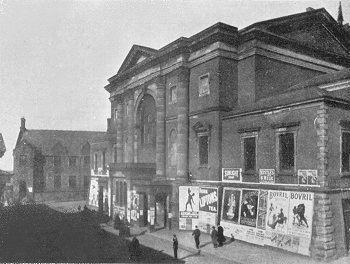
The Exchange. From the Wolverhampton
Journal. |
It took place on Christmas Eve 1896 in a show being presented at the
Exchange Hall adjacent to the Indoor Market. The building has long since
vanished but it had been a popular entertainment venue since the days in
the 1850s when Charles Dickens had come to Wolverhampton to present
public readings of his work in that hall. The Express & Star
made no other comment other than stating that a cinematograph show had
been included in the evening's entertainment. Wolverhampton's initiation
into film-going wasn't even newsworthy!
|
Tracing the early history of film-showing is thus very difficult, as
it is virtually undocumented by contemporary sources. During the years
between 1897 and 1909 films were seen by Wulfrunians in two different
settings, both of which received little attention from the press.
Firstly, films continued to be seen in a theatrical environment as brief
interludes between other acts. This was true at Wolverhampton's Empire
in Queens Square, at the Prince of Wales in Bilston Street and, from
1909 onwards, at the Pavilion in Tower Street. Films were also presented
for brief seasons at places like the Agricultural Hall at Snow Hill, and
the Drill Hall in Stafford Street.
|
The other setting in which Wulfrunians encountered pioneering film
shows was on the fairground, where the travelling cinematographic show
was called the "bioscope". Pat Collins presented his spectacular
bioscope show, "Wonderland", at the fair held on the Market Patch, at
the foot of the steps to St. Peters Church, at Whitsun 1908.
This murky period of cinema history came to an end on 1st January
1910 when the Cinematograph Act became law.
|
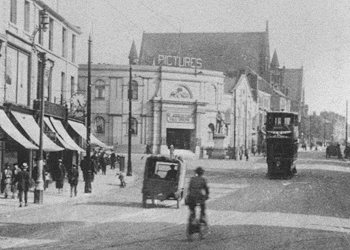
The Agricultural Hall. Courtesy of Eardley
Lewis. |
From now on films generally had to be presented in permanent premises which
could be inspected and licensed for the purpose once safety regulations had
been met.
|
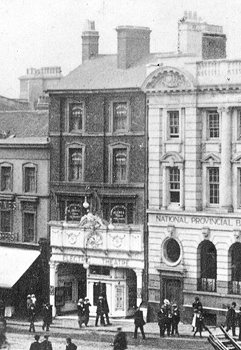
The Electric Theatre. Courtesy of Eardley
Lewis. |
In some towns the first local cinematograph licence was issued on 1st
January 1910 and the town's first cinema immediately opened its doors.
In Wolverhampton several venues were being prepared by the end of 1909
but it was the 24th January 1910 before the first was able to open its
doors to the public and lay claim to being Wolverhampton's first cinema.
The claimant was the Electric Theatre in Queens Square - premises that
were later used by Green & Hollins menswear shop, now a bank.
Immediately behind the Electric came the Olympia in Thornley Street,
which opened its doors on 14th March; it remained a cinema for fifty
years. The period from 1910 to the advent of the First World War saw the
cinema business expand very rapidly. National trends were replicated in
Wolverhampton. One trend was the development of "combines" or
"circuits"; another trend was the emergence of local cinema
entrepreneurs.
|
|
The circuit approach to the provision of new cinemas was
best illustrated in Wolverhampton by the arrival of the Queen's Cinema
in Queen Square on 30th September 1914. It was built by Associated
Provincial Picture Houses and set out to cultivate an educated middle
class audience attracted by classy tea rooms and wholesome
entertainment.
An example of the rise of the local cinema magnate is
the story of Thomas Jackson. Born in 1869 he had already built up an
enormously successful bakery and confectionery business in Whitmore
Reans by the turn of the century. His restless capitalist spirit was
always looking for something new in which to invest his money and
energy. In 1910 he was much attracted to the new cinema business. By the
end of 1912 he had opened the Coliseum on the Dudley Road at Blakenhall,
the Alhambra in Bilston and his flagship, the Strand, built on the site
of his bakehouse in Whitmore Reans. Within a year or two he had six
local cinemas under his control. The war interrupted his progress but
when the war was over Jackson had ambitious plans for most of his
cinemas - yet by 1922 his cinema business was bankrupt.
|
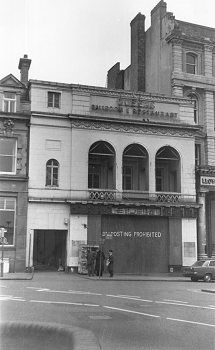
The Queens Cinema. Courtesy of David Clare. |
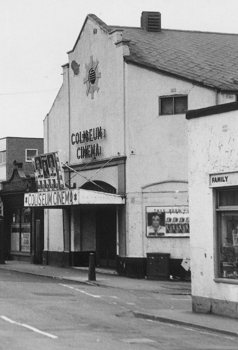
The Coliseum. Courtesy of David Clare. |
The years between the wars witnessed varying fortunes in
the cinema business and it was only the arrival of the talkies that
seemed to give the business a confident future. The first "talkie" in
Wolverhampton was "The Singing Fool", presented at the Agricultural Hall
on 12th August 1929. Record attendances led the cinema to retain the
film for a second week.
With a new sense of security the cinema business now
blossomed and the golden age of building super-cinemas quickly got
underway - the Agricultural Hall leading the way by being demolished to
be replaced by the Gaumont in 1932. The Odeon in Skinner Street opened
in 1937 and the Savoy (ABC) opened in Bilston Street at the end of the
same year. When the Second World War began Wolverhampton was very well
served with cinemas, both in the town centre and out in the suburbs.
Cinema attendances grew and grew, reaching a peak in 1946.
|
|
The post-war history of cinemas in a town like
Wolverhampton is quite complex but the end result is fairly clear. A
long decline began in the 1950s which has only been reversed by the
comparatively recent emergence of the "multiplex". Film presentation has
never really vanished in Wolverhampton, even when most people believed
it had somehow faded away like the fade-out on the end of a film.
When the ABC closed on 17th October 1991 town-centre
film-presentation was preserved at the Light House in Fryer Street, but
the venture has been poorly supported by Wulfrunians and the Light House
itself ceased showing films on a full time basis in 1998, although
currently films are again on show. The situation is complicated and
still likely to change.
|
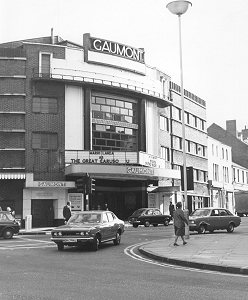
The Gaumont, Snow Hill. |
Three multiplex cinemas now operate in the Black Country and
Wulfrunians now jump in a car to go to the pictures. Hoyt's, the
Australian cinema chain, even proposed to run a cinema on the Low Level
station site; but nothing came of it. Yet more multiplex cinemas are
planned. It is still a case of "Watch This Screen - the Cinema ain't
dead yet!"

|









